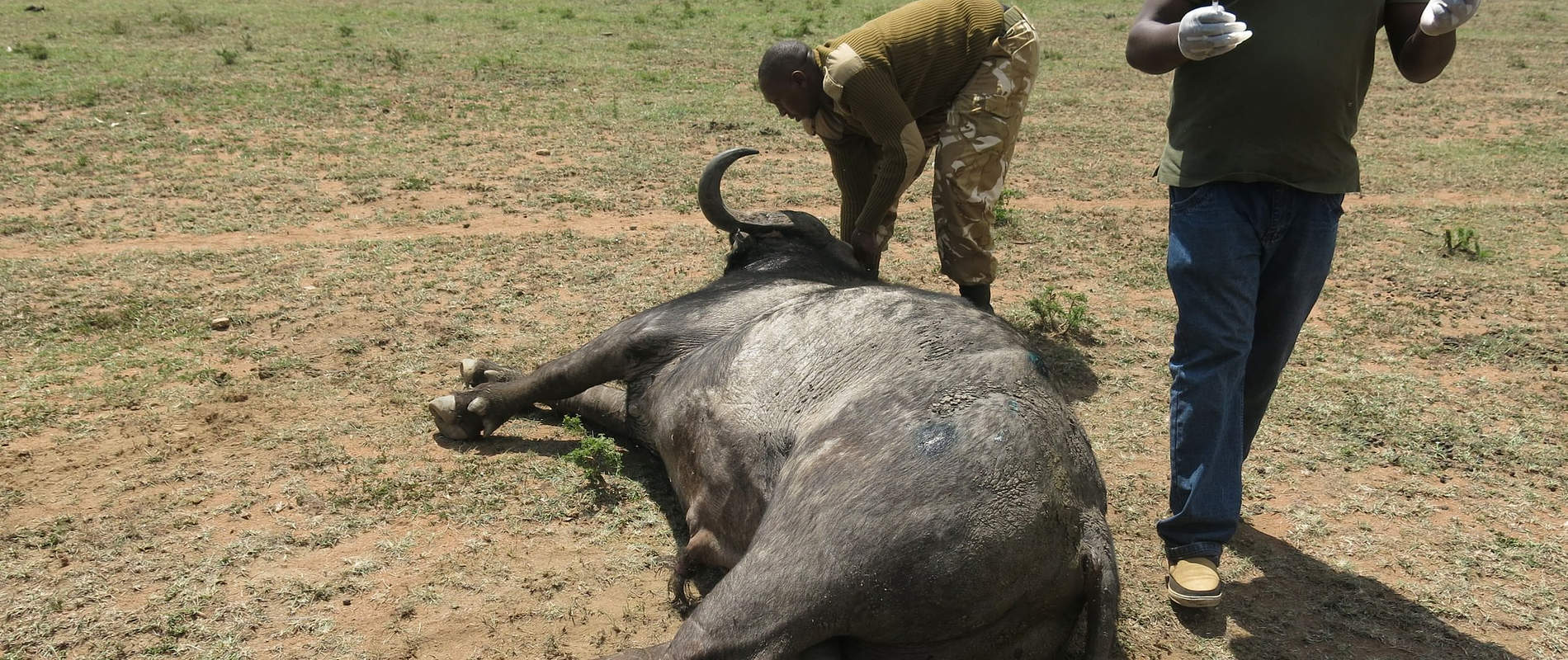Introduction The month was characterised by increased precipitation with adequate forage for browsing and grazing species to utilise
Introduction
The month was characterised by increased precipitation with adequate forage for browsing and grazing species to utilise. Water is also adequately available for all animals to use. Most elephants are in the conservancies and community areas while the migratory wildebeests occupy most parts of the reserve. Human-wildlife conflict cases are still being recorded with an elephant being treated for a spear injury and arrowheads being retrieved from an elephant and a zebra foal.
The following were cases handled during the month;
1. TREATMENT OF AN ELEPHANT BULL
Date: 6th September 2017
Species: African elephant
Sex: Male
Age: Adult
Location: Olarro conservancy (Ngeneji area)
History
This elephant was seen with a large herd browsing within the conservancy. It was reported that this big herd had recently come to the conservancy. The conservancy management noticed he was walking with a limp and called the veterinary unit for intervention.
General observation
This bull was seen browsing with a big herd within the conservancy. He was in good body condition though with a small swelling on the inner side of his left thigh.
Immobilization, examination and treatment
He was chemically restrained by use of 15mgs etorphine hydrochloride delivered through a 1.5mldaninject dart from a vehicle.Induction time was eight minutes and he went down on his left lateral. Examination revealed a swelling on the inner side of his left thigh with a partially healed wound. The wound was opened and further probe revealed a metallic foreign object lodged. This was an arrowhead that had been in place for approximately two weeks.
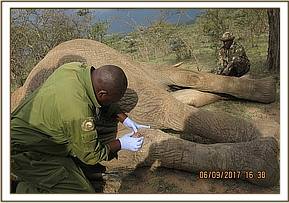
The arrowhead was gently removed and the resultant wound debrided with hydrogen peroxide. It was rinsed with clean water and disinfected with tincture of iodine. Green clay was then packed. Additional treatments include parenteral administration of 30000mgs amoxicillin antibiotics and 5000mgs flunixin meglumine anti-inflammatory.
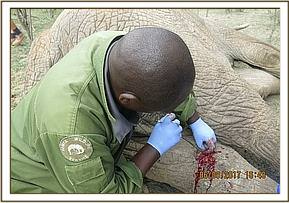

Reversal
Achieved by intravenous administration of 36mgs diprenorphine hydrochloride through a prominent ear vein. He woke up to join the rest of the herd in four minutes.


Prognosis
Good
2. INJURED ZEBRA FOAL
Date: 7th September 2017
Species: Common zebra
Age: Foal
Sex: Female
Location: Olalaimutiak
History
This zebra foal was seen with an arrow lodged on her right rump by warden in charge of Olalaimutiak sector within Masai Mara National Reserve. He sought our services to intervene.
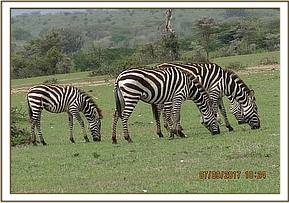
Immobilization, examination and treatment
Immobilization was achieved by use of combination of 2mgs etorphine hydrochloride and 20mgs azaperone delivered through a 1.5mldaninjectdart. Darting was done from a vehicle. It took four minutes for the drugs to take full effect. An arrow lodged on his right rump was retrieved.
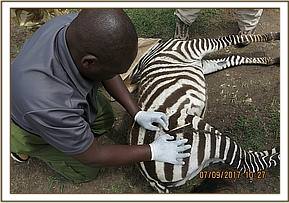

The resultant wound was thoroughly cleaned to remove dead tissues and disinfected with tincture of iodine. She also received intramuscular injection of 750mgs amoxicillin antibiotic and 500mgs flunixin meglumine anti-inflammatory.
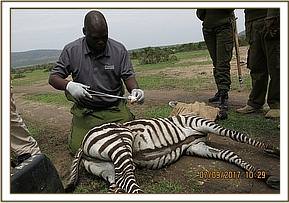

Reversal
Achieved by intravenous injection of 6mgs diprenorphine hydrochloride through the jugular vein.
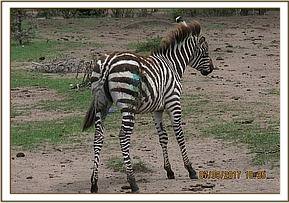
She woke up in two minutes to join her mother.
Prognosis.
Good
3. SPEARED ELEPHANT
Date: 7th September 2017
Species: African elephant
Sex: Male
Age: Adult
Location: Naboisho conservancy
History
This big tusker was reported injured by Naboisho conservancy management. The veterinary team responded by visiting for assessment and intervention.
General observation
This bull appeared agitated with a relatively fresh open wound on the lateral side of his front right limb.
Immobilization, examination and treatment
Restraint was achieved by use of 17mgs etorphine hydrochloride delivered in a 3mldaninject dart from a vehicle. It took ten minutes for this elephant to be fully narcotized. He assumed left lateral recumbency at the edge of a bush.
Examination revealed a fresh spear wound on the lateral side of his right front leg likely caused by a spear. Probing of the wound yielded no foreign body but muscles around this area were partially split.
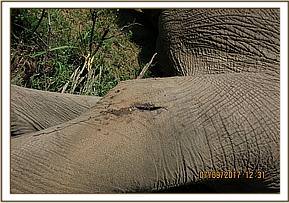

The wound was debrided and rinsed with clean water. Tincture of iodine was used as a disinfectant before green clay being packed to absorb toxins and hasten healing.Other treatments include parenteral administration of 30000mgs amoxicillin antibiotic and 5000mgs flunixin meglumine anti-inflammatory.


Reversal
Achieved by intravenous administration of 42mgs diprenorphine hydrochloride. He rose up after four minutes and retreated into the bush.
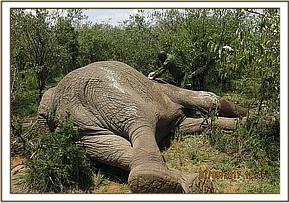
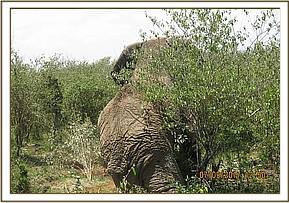
Prognosis
Good
4. INJURED ELEPHANT
Date: 10th September 2017
Species: African elephant
Sex: Female
Age: Adult (About 50 years old)
Location: Olpopongi (Siana area)
History
This tuskless matriarch was seen in a bad condition by the Elephant Aware and Olarro conservancy team who called the mobile veterinary unit for intervention.
General observation
This old female with her three calves was seen in poor condition with an old discharging wound on her left flank.
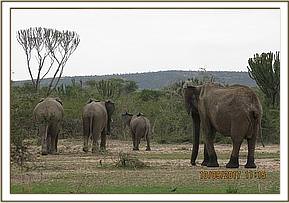
Immobilization, examination and treatment
Restraint was achieved chemically by use of 13mgs etorphine hydrochloride, this being approximately ¾ of dose for an adult female owing to her condition. However, she could not be fully narcotized with this dose as she stood still partially anaesthetized. Additional 3mgs etorphine was given remotely through darting. It took another two minutes for the drugs to take full effect and she assumed right lateral recumbency.
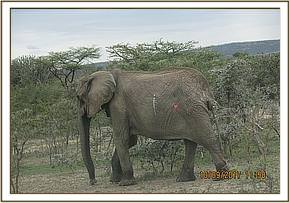
Examination revealed an old septic wound most likely caused by an arrow. Probing revealed no foreign body as the arrow could have since fallen. The wound was cleaned and debrided with the help of hydrogen peroxide. It was disinfected with tincture of iodine before green clay being packed to absorb toxins and hasten healing.


This old female in addition received intramuscular injection of 30000mgs amoxicillin antibiotic and 5000mgs flunixin meglumine anti-inflammatory. All along her calves were patiently waiting nearby.
Reversal;
Done by intravenous administration of 42mgs diprenorphine hydrochloride through a prominent ear vein. With the use of ropes, she was helped to rise up and join her calves.


Prognosis
Fair.
Close monitoring is being carried out on her and so far, indications show she is improving.
5. SNARED BUFFALO BULL
Date: 11th September 2017
Species: Cape buffalo
Sex: Male
Age: Adult
Location: Mara Triangle Conservancy
History
This old bull was seen with a plain shiny wire snare by the Mara Triangle Patrol rangers. The snare was loosely attached to his rare left leg. He was with two other lone bulls. His body condition appeared pathetic due to old age.
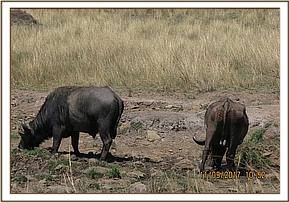
Immobilization
He was restrained chemically by use of a combination of 6mgs etorphine and 50mgs azaperone tartarate delivered through a 1.5mldaninject dart from a vehicle. He was recumbent in eight minutes assuming sternal recumbency. This buffalo was stabilized before the snare being released.
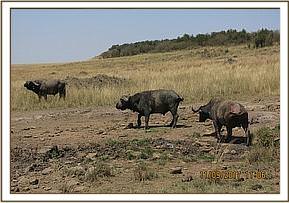
As soon as the snare was removed, he regurgitated and aspirated the regurgitates chocking himself. All attempts to resuscitate him were fruitless.
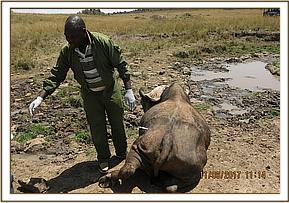
A quick post-mortem was then carried out with the following findings;
All incisors were completely worn out to the base.
The molars were also worn out with several of them loosely attached.
The muscle cover was poor with the muscles themselves showing signs of age related cachexia.
Liver was more fibrotic tending towards cirrhosis. There was evidence of fluke infestation.
Lungs had Ingesta aspirates and this could have caused asphyxia.
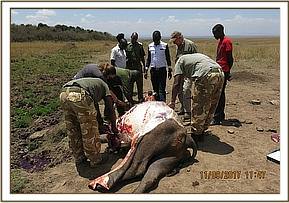
Conclusion
This old bull died of asphyxia, having aspirated gastrointestinal regurgitates. The cachexic state of his body condition associated with age meant gastrointestinal sphincter muscles were weak allowing ease of gastric refluxes and this was made worse by anaesthesia.
6. EAR TAGGING OF BLACK RHINO
Date: 12th September 2017
Species: Black Rhino
Sex: Female
Age: Adult
Location: Mara Triangle
History
This female, about seven years old is known to move out of the conservation area occasionally straying far and wide to community areas with risk of being poached.

The recent straying having occurred weeks before this exercise where she spent several weeks outside Mara triangle before eventually coming back.For ease of monitoring, Mara Triangle Management, Mara Elephant Project and KWS teams decided to deploy a solar powered GSM/Satellite tag on the ear of this rhino.
Capture and tagging
Restraint was achieved chemically by use of a combination of 4.5mgs etorphine hydrochloride and 70mgs azaperone delivered through a 1.5mldaninject dart.Darting was done from a helicopter. It took about ten minutes for the drugs to take full effect with the rhino assuming sternal recumbency. She received 5mgs butorphanol to stabilise her before the tag being placed. The tracking tag was placed on an appropriate location on her left ear and the soundness of the device tested before the rhino being revived.
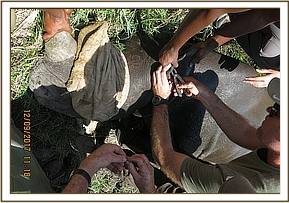

Reversal
This rhino was reversed by use of 18mgs diprenorphine given intravenously through a prominent ear vein. Another 75mgs of naltrexone was administered intramuscularly as a backup. She got up within three minutes of reversal and moved away.

It is reported the signal is still working and so far she has not left the protected area.
7. TREATMENT OF A BUFFALO
Date: 12th September 2017
Species: Cape buffalo
Sex: Male
Age: Adult
Location: Olare Motorogi Conservancy (Porini Camps)
History
This bull among other three lone bulls were seen with a plastic pipe round his left hind leg by the Olare Motorogi patrol rangers. They called the veterinary unit for intervention.
General observation
This buffalo was seen by the edge of a small thicket with his mates with a plastic pipe round his left hind leg. He stood up but moved with pain.
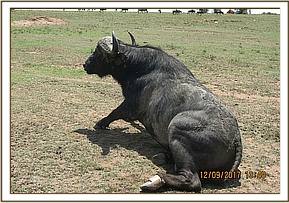

Immobilization, examination and treatment
Immobilization was achieved by use of combination of 7mgs etorphine hydrochloride and 50mgs azaperone delivered through a 1.5mlsdaninject dart from a vehicle. He was recumbent after eight minutes assuming sternal position.
The plastic piping had injured lower portion of his left hind leg with fresh wounds created by the edges of the pipe. It was assumed he stepped on this waste pipe. This pipe was cut loose and released with the resultant wound being cleaned and disinfected with tincture of iodine. Oxytetracycline spray was then applied before amoxicillin antibiotic and flunixin meglumine anti-inflammatory being administered parenterally.
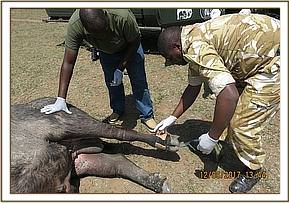

Reversal
Achieved by administration of 18mgs diprenorphine intravenously through a prominent ear vein. He woke up within three minutes to join the rest of the bulls.
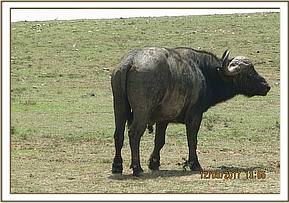
Prognosis
This buffalo is expected to make a full recovery.
8. ELEPHANT CALF RESCUE
Date: 15th September 2017
Species: African elephant
Sex: Male
Age: 2 years
Location: Mara Triangle
History
This baby had been seen wandering alone for some days by the Mara triangle security team. It was hoped he could find his family and eventually his mother. However, as days passed by, no family of elephants accepted him and a decision to rescue him was arrived at.
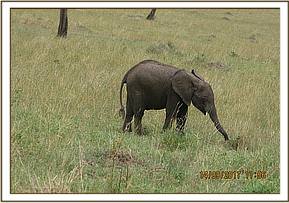
Capture and rescue
He was found wandering alone in the plains. He was darted by use of 50mgs azaperone to calm him before being restrained manually with ropes and loaded to a vehicle to Serena airstrip. His body condition was satisfactory and was taken by plane to the DSWT elephant orphanage in Nairobi for care.
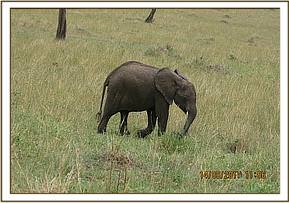
9. INJURED LIONESS
Date: 20th September 2017
Species: African lion
Sex: Female
Age: Adult
Location: Olare-Motorogi conservancy
History
This lioness was spotted with injuries on her flanks by Olare-Motorogi patrol rangers. They called the veterinary unit for intervention.
General observation
This lioness was found under a shade with wounds on both of her flanks. She had difficulty rising.
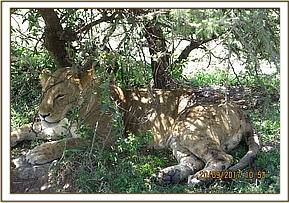

Immobilization, examination and treatment
She was restrained chemically by use of a combination of 4.8mgs medetomidine and 230mgs ketamine delivered through a 3mldaninject dart from a vehicle. She got fully anaesthetized after ten minutes whereupon a blindfold and eye ointment was put in place.
Examination revealed a big wound splitting some flank muscles on her right flank and bite wounds on her left flank towards her back. All the wounds appeared fresh with the right one thought to have been caused by a buffalo gore. A number of hyenas were seen trailing this lioness and may have tried to attack her after the buffalo injury causing the multiple bites on her left backside.
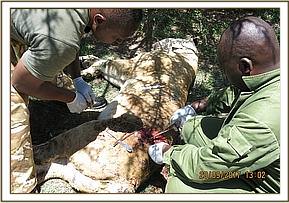
The right flank wound was cleaned, and absorbable sutures used to repair the torn muscles.
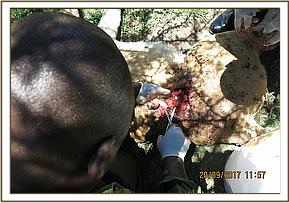
Skin was shaved, disinfected, trimmed and apposed with vicryl suture. The other bite wounds were disinfected with tincture of iodine with deeper wounds being stitched.
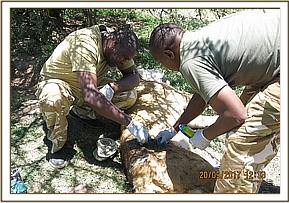
Green clay was applied to all the wounds to hasten healing before the lioness being reversed.
Reversal
Done one and half hours after immobilization by intramuscular administration of 15mgsatepamezole hydrochloride. She woke up after ten minutes and was stable within fifteen minutes.
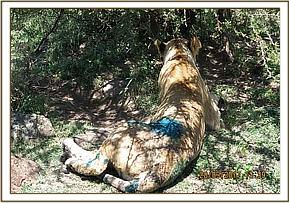

Prognosis.
Good
10. ELEPHANT CALF RESCUE
Date: 23rd September 2017
Species: African elephant
Age: 2 weeks
Sex: Male
Location: Mara North
History
This baby elephant was found in the morning having been trapped by a tree stumpalong the banks of the Mara River. He seemed to have fallen from the edge of the river bank and luckily got trapped before submerging into the water. He was rescued by the Serian camp team exhausted and hungry. An attempt to look for his family and mother was fruitless as those nearby were all males and none of the few females seen could accept him as all of them had their babies.
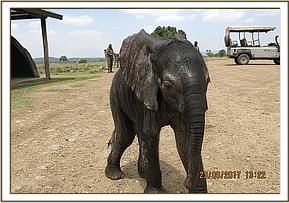

Way forward
When it became evident that tracing the mother was impossible whilst at the same time, the baby was getting weary by the hour, the option of taking him for care at Nairobi elephant orphanage was arrived at. Another day without the mother and milk would have meant increased chances of losing this baby. In the best interest of this lonely calf, the decision to rescue him and take him to the nursery was the only good option.
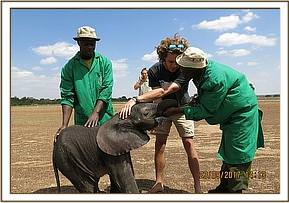
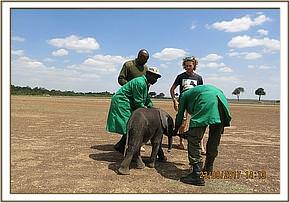
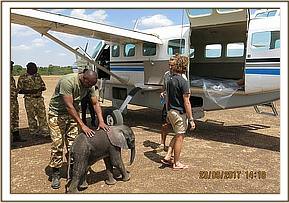

11. LION TREATMENT
Date: 25th September 2017
Species: African lion
Sex: Male
Age: Young adult
Location: Masai Mara National Reserve (Lookout area)
History
This young adult was seen with bite injuries by management of Matira camps. They called the veterinary unit for intervention.
General observation
This lion was found lying close to a Lugga in good body condition. He had an injury on his right hind leg with part of his tail missing and with fresh injury. All the injuries appeared to have been inflicted by other lions possibly from territorial conflicts.
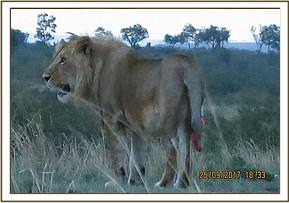
Immobilization, examination and treatment
Restraint was achieved chemically by use of a combination of 4.8mgs medetomidine and 250mgs ketamine delivered through a 3mldaninject dart.Darting was done from a vehicle. This lion was fully anaesthetized after ten minutes upon where a blindfold and eye ointment were put in place.
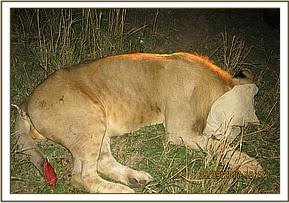
All the wounds were debrided with the help of hydrogen peroxide and disinfected with tincture of iodine. Oxytetracycline spray was then applied topically.
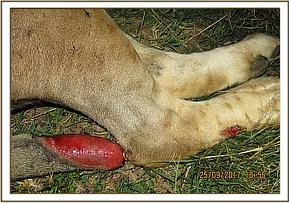

Other treatments include parenteral administration of 3000mgs amoxicillin antibiotic and 80mgs ivermectin parasiticidal. The tail wound is expected to heal by granulation though it will take some time.
Reversal
Achieved by intravenous administration of yohimbine one hour after immobilization. He woke up in four minutes and was stable after eight minutes.
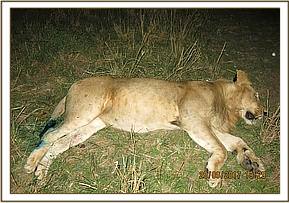
Prognosis
Good
